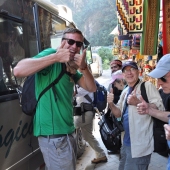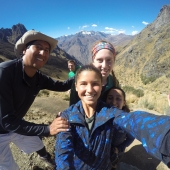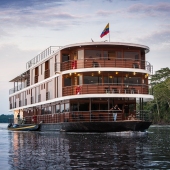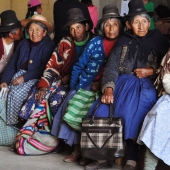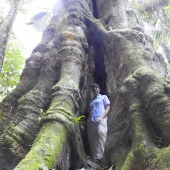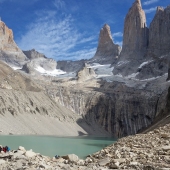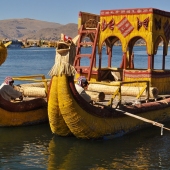Machu Picchu in 1977
Machu Picchu Memory
By Bob Fisher
Some moments in time, like the shared revisiting of the past as in "Where were you when...?" are not only enduring but universal in their implications. And then there are individual moments in time that are often shared with only a few individuals. In either case, as the song says, "The memories linger on". But human memory -- whether individual, collective, or cultural -- is all-embracing; a critical brain function that makes our species unique. And many additional layers of memory can also found in landscapes, like that at Machu Picchu.
Layers of memory Landscape memory is especially relevant at Machu Picchu, a poignant and spectacular last refuge and point of 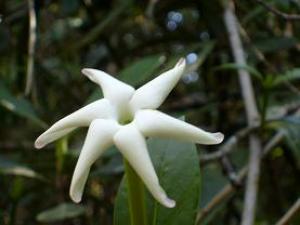 resistance for the Inca. When we visited it in 1977, the site did not fail to take us by surprise, as it has done for so many since Hiram Bingham first "re-discovered" it in 1911. On a mountain ridge high above the Urubamba Valley in Peru, its stunning topography and environs have enigmatic and even mystical qualities. At Machu Picchu you come very close to a glimpse of the eternal. This is a once-in-a-lifetime travel experience that I daresay is a place where perception, on all levels, is intensified and magnified; and stored in the unconscious mind forever. But Machu Picchu is also a destination in which the subconscious also plays a key role. There is probably no more rarified site in which to fully appreciate an intense sense of place, solitude, and mindfulness than this pre-Columbian Inca site. Once visited, Machu Picchu becomes an iconic travel experience. Wandering through this UNESCO World Heritage Site (and Peruvian Historical Sanctuary), your senses and imagination are in free flow. Unlike many archaeological "ruins", here you can easily visualize and feel the presence of an ancient civilization.
resistance for the Inca. When we visited it in 1977, the site did not fail to take us by surprise, as it has done for so many since Hiram Bingham first "re-discovered" it in 1911. On a mountain ridge high above the Urubamba Valley in Peru, its stunning topography and environs have enigmatic and even mystical qualities. At Machu Picchu you come very close to a glimpse of the eternal. This is a once-in-a-lifetime travel experience that I daresay is a place where perception, on all levels, is intensified and magnified; and stored in the unconscious mind forever. But Machu Picchu is also a destination in which the subconscious also plays a key role. There is probably no more rarified site in which to fully appreciate an intense sense of place, solitude, and mindfulness than this pre-Columbian Inca site. Once visited, Machu Picchu becomes an iconic travel experience. Wandering through this UNESCO World Heritage Site (and Peruvian Historical Sanctuary), your senses and imagination are in free flow. Unlike many archaeological "ruins", here you can easily visualize and feel the presence of an ancient civilization.
Spirits Most historians and archaeologists believe that Machu Picchu was built as a retreat for the Inca emperor Pachacuti with construction beginning as early as AD 1400. And when it eventually got "lost" in the mists of time, following the Spanish conquest of the extensive Inca empire, Machu Picchu retreated from the consciousness of "the outside world" for a considerable length of time. And when Bingham journeyed here, it experienced a kind of renaissance, soon becoming celebrated as a masterpiece of classical Inca architecture and style. If you are able to spend even one day -- and pass among the spirits of the site especially from dusk to dawn as we were so fortunate to do "way back then" when Machu Picchu was less visited -- you may also catch a glimpse of the ethereal in this magnificent site.
Travellers without baggage This was our big trip to South America. Unlike the usual Grand Tour of Europe we all did in those days, we came to Peru and ultimately to Machu Picchu with few pre-conceived notions and, from a sensory point of view, quite innocent. It was, and remains, the stuff of holistic memory. Discrete and contained, Machu Picchu is a gestalt experience, engendering both sense and sensibility. It also challenges spatial perceptions and intensifies all your senses.
El condor pase... Machu Picchu also challenges that element of memory known as body orientation. Although gravity plays its essential role at the site, there is initially a perplexing sense of disengagement and disorientation. "Where exactly am I? How did I get here? How close are those other peaks? How many layers of blue does that infinite sky contain?" Perhaps it's the altitude. And when we saw the condor drifting on thermals arising from the valley below -- at times this equally iconic bird seemed to be just above our heads; at others it was horizontal to our sight lines -- time and space coalesced.
Orchids and other "hazards" We were told not to step off the path to view the rare orchids at Machu Picchu lest we inadvertently find ourselves in some post-mortal state. But who could resist looking at such exquisite flowers in this prodigious environment? And at Machu Picchu you may also risk being entranced by the site's engineering marvels. As you ascend and descend the many stone stairways and steps and meander through the terraces (the site was also in many ways an agricultural research station), you will pass polished stone walls that typify classical Inca architecture. The latter were sculpted from large stones with impeccable precision so as to fit tightly together without mortar. Do not be surprised if you find yourself murmuring, "How did they do this?" At daybreak the mists rise from the Urubamba 450 metres below. And as you are saying goodbye, for now, to Machu Picchu, and wandering among the llamas and alpaca peacefully grazing in Machu Picchu's courtyards, do not be alarmed if you enter a transcendent state of mind.
The Philosophical Traveller
Ready to reserve your trip-of-a-lifetime to Machu Picchu? Contact our US office for information.


